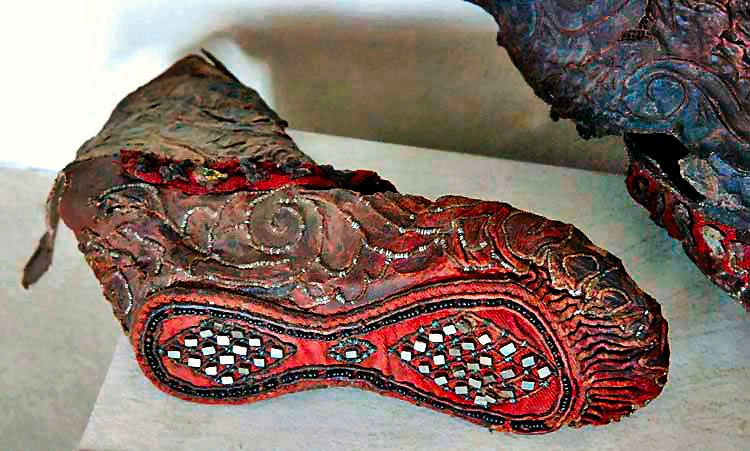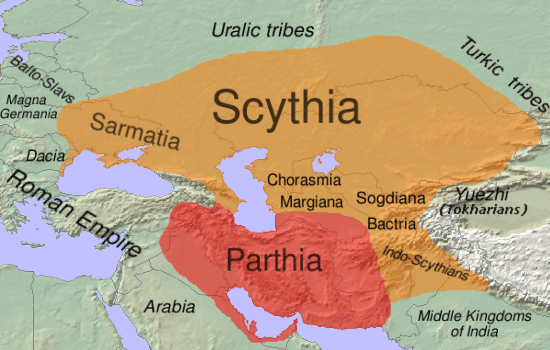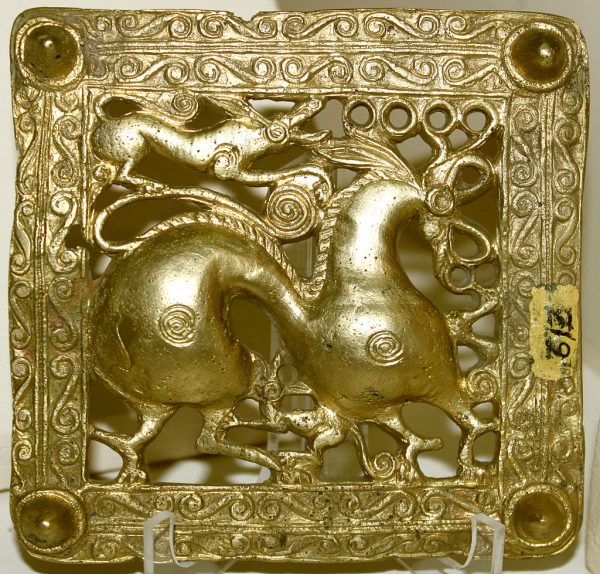2300-Year-Old Scythian Woman’s Boot Preserved in the Frozen Ground

The Altai Mountains run through Central and East Asia for about twelve hundred miles from the southeast to the northwest, spanning China, Mongolia, Russia, and Kazakhstan.
Much of the land contains burials from thousands of years ago which have been preserved due to the permafrost that covers the area.

Not only does the permafrost preserve the bodies, but personal items buried with the deceased as well. As the Egyptians mummified the corpses and buried personal items and goods that would be used in the afterlife, so did the Scythians, a nomadic tribe that inhabited the area from about the ninth to the second century BC.
Many beautiful objects have been found, but a pair of women’s boots may arguably be the most attractive object found to date. The boots, made of leather and other textiles, are decorated with beads, woolen braid, and sewn-on patches with gold leaf.
HD photo pic.twitter.com/3eo0whVEBn
— HappyBoat🇯🇵🇰🇷 (@cliffgreen77) June 18, 2020
Beaded lotus leaves are spaced around the boots in graceful patterns, and the soles are decorated with more beads and small rectangular pieces of pyrite.
The pyrite shows no sign of wear leading researchers to believe the shoes may have been worn by an extremely important woman for special occasions or they were made for her to wear when she was buried.
British Museum curators, according to Open Culture, have speculated that Scythians prized the soles of their boots as they sat around communal fires exposing them to the view of their neighbors.
The boots, which now reside in the State Hermitage Museum in St. Petersburg, Russia, have been carbon-dated to about two thousand three hundred years ago.
As the Scythians were nomads, everything they owned had to be lightweight and small. According to The British Museum, a number of small collapsible tables have been found in tombs in the Altai mountains.

There have been some that were only about seven inches tall, and others were found that stood about eighteen inches tall. The legs were removable and most were colored red by cinnabar.
Scythians apparently loved decoration and had highly skilled craftsmen who worked with wood, gold, bronze, textiles, and iron to craft tools, clothing, gold plaques, jewelry, and other decorative items for headdresses for chiefs and horses.
The only things the pastoral nomads left behind were the meticulously fashioned tombs covered with mounds of soil. Most graves hold important people that would have had the financial means to have such tombs made for them.
Curators for the British Museum, on Open Culture, explain that Scythians crafted wooden structures at the bottom of deep holes.

The roof of a structure would be covered with moss, larch, and birch bark while the inside was lined with dark felt. A coffin made from a log was placed inside this unusual tomb, and the body would be laid to rest with their valuables.
Warriors horses, important in Scythian society because they provided mobility, milk, meat, and hides for clothing, might be slaughtered and placed in the shaft as well, facing east.
Most horses were buried with elaborate headdresses that often gave the animal the appearance of a mythical beast and the elaborate reins, halters, saddles, and headdresses they wore in life.
World Archaeology tells us most of the human bodies were found to have been covered with tattoos and had evidence of falls and broken bones, some of which seem to have been caused by violence.
Some of the remains showed diseases such as breast cancer, suffered by a woman in her twenties who had died from injuries consistent with a fall from a horse or infections such as that caused by bovine tuberculosis and prostate cancer found in a middle-aged ruler who probably spent the last few months of his life in bed.
Another article from us: The Bog Bodies of Northern Europe Perfectly Preserved After 1000s of Years
The young woman’s tomb also contained a brazier with burnt hemp which leads scientists to believe the Scythians were aware of its painkilling properties.
